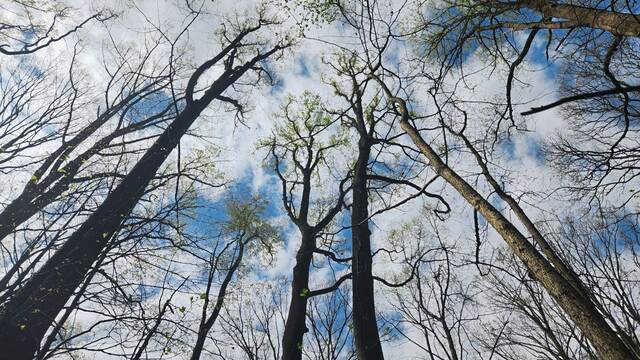https://naviga.triblive.com/local/westmoreland/bushy-run-battlefield-will-be-inducted-into-national-old-growth-forest-network/
Bushy Run Battlefield now part of the national Old-Growth Forest Network

Each year, Bushy Run Battlefield is the site of historical reenactments. But some of its trees may have been around nearly long enough to have seen the real thing.
The battlefield — specifically the forested section of its property — was inducted into the Old-Growth Forest Network at a May 4 ceremony in Penn Township.
“We have more than 200 acres of fields and forests, and one of our volunteers, Adrian Weaver, was familiar with the network from working in other parks,” said Bushy Run manager Matt Adams. “She thought we’d be a good fit for the network.”
Weaver, a North Huntingdon resident who volunteers as a trail steward at Bushy Run, said it’s crucial to preserve mature forests in Pennsylvania.
“We don’t have a lot of old growth,” Weaver said. “The old growth areas and those cathedral pines in Cook Forest are really beautiful. It really is vitally important because people don’t realize the history behind the land we have.”
Brian Kane, the network’s Mid-Atlantic regional manager, said only about 1% of forested land on the East Coast is considered old-growth.
“They’re abundant with wildlife and habitat, particularly for a lot of rare species that can’t find habitat in other forested areas,” he said. “Some of them require old growth, whether it’s the hollow areas of tree or the composition of the soil around them.”
A significant portion of old growth today, at least in Pennsylvania, is actually second-growth forest. Between the early 1800s and the turn of the 20th century, the demand for lumber stripped much of Pennsylvania’s virgin forest to the bare earth, according to the Warren County Historical Society.
Continuing through the 1930s, the new wood chemical industry — charcoal, acetic acetate, wood alcohol and other products — drove the demand further, according to the society, decimating the forests of the Allegheny Plateau and beyond.
Today’s Pennsylvania forests are no longer dominated by pines and hemlocks. The second generation of forest growth was largely hardwood trees and black cherry.
Westmoreland County is home to two stands of old-growth forest that are part of the network. One section covering between 5 and 7 acres was designated in Murrysville’s Duff Park in 2011. Another is on the Powdermill Nature Reserve property in Ligonier Township. Powdermill’s 2,000 acres contain sugar maple, beech, black cherry, tulip poplar, hemlock, many types of oak and more.
At Bushy Run, there are nearly 140 acres of mixed deciduous forest. Weaver and other volunteers estimated that the oldest trees are between 170 and 210 years old and are located not far from the main loop of the site’s Edge Hill Trail.
A look at some of the old-growth trees at Bushy Run Battlefield in Penn Twp. pic.twitter.com/gZ9Umh1kAN— Patrick Varine - Tribune-Review (@VarineTrib) April 18, 2024
There is not an easy way to determine the exact age of a tree without damaging it. In Murrysville, Westmoreland Conservation District officials determined relative age by measuring the trees’ height and circumference. At the time, the tallest was a 145-foot red oak.
A forest is considered old growth if it contains trees that have not been cut for 150 years or more. Western Pennsylvania has a little more than a dozen areas that have been granted the designation. They have formal protections in place to ensure their trees and ecosystems are not subject to commercial logging, and they are open to the public so they can be enjoyed.
“We want to make sure people understand the significance of the native species and the plants we have on that land,” Weaver said. “It’s great to come see it for yourself, and it’s good to put this extra layer of protection on the land, because you just don’t know what could happen in the future.”
Kane agreed.
“We feel it’s important for the public to be able to see and access old-growth forests,” he said. “You can understand them much more fully and appreciate their beauty and their importance when you walk through one of those areas.”
Copyright ©2025— Trib Total Media, LLC (TribLIVE.com)
